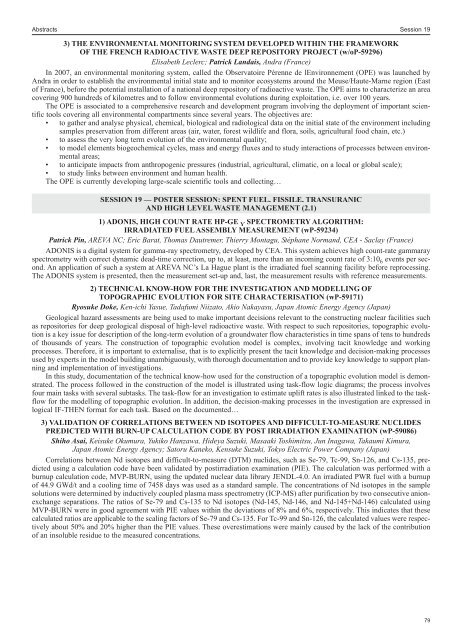ICEM11 Final Program 9.7.11pm_ICEM07 Final Program ... - Events
ICEM11 Final Program 9.7.11pm_ICEM07 Final Program ... - Events
ICEM11 Final Program 9.7.11pm_ICEM07 Final Program ... - Events
Create successful ePaper yourself
Turn your PDF publications into a flip-book with our unique Google optimized e-Paper software.
Abstracts Session 19<br />
3) THE ENVIRONMENTAL MONITORING SYSTEM DEVELOPED WITHIN THE FRAMEWORK<br />
OF THE FRENCH RADIOACTIVE WASTE DEEP REPOSITORY PROJECT (w/oP-59296)<br />
Elisabeth Leclerc; Patrick Landais, Andra (France)<br />
In 2007, an environmental monitoring system, called the Observatoire Pérenne de lEnvironnement (OPE) was launched by<br />
Andra in order to establish the environmental initial state and to monitor ecosystems around the Meuse/Haute-Marne region (East<br />
of France), before the potential installation of a national deep repository of radioactive waste. The OPE aims to characterize an area<br />
covering 900 hundreds of kilometres and to follow environmental evolutions during exploitation, i.e. over 100 years.<br />
The OPE is associated to a comprehensive research and development program involving the deployment of important scientific<br />
tools covering all environmental compartments since several years. The objectives are:<br />
• to gather and analyse physical, chemical, biological and radiological data on the initial state of the environment including<br />
samples preservation from different areas (air, water, forest wildlife and flora, soils, agricultural food chain, etc.)<br />
• to assess the very long term evolution of the environmental quality;<br />
• to model elements biogeochemical cycles, mass and energy fluxes and to study interactions of processes between environmental<br />
areas;<br />
• to anticipate impacts from anthropogenic pressures (industrial, agricultural, climatic, on a local or global scale);<br />
• to study links between environment and human health.<br />
The OPE is currently developing large-scale scientific tools and collecting…<br />
SESSION 19 — POSTER SESSION: SPENT FUEL, FISSILE, TRANSURANIC<br />
AND HIGH LEVEL WASTE MANAGEMENT (2.1)<br />
1) ADONIS, HIGH COUNT RATE HP-GE Ƴ SPECTROMETRY ALGORITHM:<br />
IRRADIATED FUEL ASSEMBLY MEASUREMENT (wP-59234)<br />
Patrick Pin, AREVA NC; Eric Barat, Thomas Dautremer, Thierry Montagu, Stéphane Normand, CEA - Saclay (France)<br />
ADONIS is a digital system for gamma-ray spectrometry, developed by CEA. This system achieves high count-rate gammaray<br />
spectrometry with correct dynamic dead-time correction, up to, at least, more than an incoming count rate of 3:106 events per second.<br />
An application of such a system at AREVA NC’s La Hague plant is the irradiated fuel scanning facility before reprocessing.<br />
The ADONIS system is presented, then the measurement set-up and, last, the measurement results with reference measurements.<br />
2) TECHNICAL KNOW-HOW FOR THE INVESTIGATION AND MODELLING OF<br />
TOPOGRAPHIC EVOLUTION FOR SITE CHARACTERISATION (wP-59171)<br />
Ryosuke Doke, Ken-ichi Yasue, Tadafumi Niizato, Akio Nakayasu, Japan Atomic Energy Agency (Japan)<br />
Geological hazard assessments are being used to make important decisions relevant to the constructing nuclear facilities such<br />
as repositories for deep geological disposal of high-level radioactive waste. With respect to such repositories, topographic evolution<br />
is a key issue for description of the long-term evolution of a groundwater flow characteristics in time spans of tens to hundreds<br />
of thousands of years. The construction of topographic evolution model is complex, involving tacit knowledge and working<br />
processes. Therefore, it is important to externalise, that is to explicitly present the tacit knowledge and decision-making processes<br />
used by experts in the model building unambiguously, with thorough documentation and to provide key knowledge to support planning<br />
and implementation of investigations.<br />
In this study, documentation of the technical know-how used for the construction of a topographic evolution model is demonstrated.<br />
The process followed in the construction of the model is illustrated using task-flow logic diagrams; the process involves<br />
four main tasks with several subtasks. The task-flow for an investigation to estimate uplift rates is also illustrated linked to the taskflow<br />
for the modelling of topographic evolution. In addition, the decision-making processes in the investigation are expressed in<br />
logical IF-THEN format for each task. Based on the documented…<br />
3) VALIDATION OF CORRELATIONS BETWEEN ND ISOTOPES AND DIFFICULT-TO-MEASURE NUCLIDES<br />
PREDICTED WITH BURN-UP CALCULATION CODE BY POST IRRADIATION EXAMINATION (wP-59086)<br />
Shiho Asai, Keisuke Okumura, Yukiko Hanzawa, Hideya Suzuki, Masaaki Toshimitsu, Jun Inagawa, Takaumi Kimura,<br />
Japan Atomic Energy Agency; Satoru Kaneko, Kensuke Suzuki, Tokyo Electric Power Company (Japan)<br />
Correlations between Nd isotopes and difficult-to-measure (DTM) nuclides, such as Se-79, Tc-99, Sn-126, and Cs-135, predicted<br />
using a calculation code have been validated by postirradiation examination (PIE). The calculation was performed with a<br />
burnup calculation code, MVP-BURN, using the updated nuclear data library JENDL-4.0. An irradiated PWR fuel with a burnup<br />
of 44.9 GWd/t and a cooling time of 7458 days was used as a standard sample. The concentrations of Nd isotopes in the sample<br />
solutions were determined by inductively coupled plasma mass spectrometry (ICP-MS) after purification by two consecutive anionexchange<br />
separations. The ratios of Se-79 and Cs-135 to Nd isotopes (Nd-145, Nd-146, and Nd-145+Nd-146) calculated using<br />
MVP-BURN were in good agreement with PIE values within the deviations of 8% and 6%, respectively. This indicates that these<br />
calculated ratios are applicable to the scaling factors of Se-79 and Cs-135. For Tc-99 and Sn-126, the calculated values were respectively<br />
about 50% and 20% higher than the PIE values. These overestimations were mainly caused by the lack of the contribution<br />
of an insoluble residue to the measured concentrations.<br />
79
















